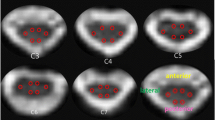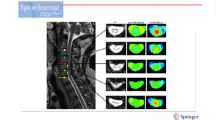Abstract
Purpose
The aim of this study was to assess the potential role of diffusion tensor imaging (DTI) as a predictor of surgical outcomes in patients with cervical compressive myelopathy (CCM). Surgical decompression is often recommended for symptomatic CCM. It is important to know the prognosis of surgical outcomes and to recommend appropriate timing for surgery.
Methods
We enrolled 26 patients with CCM who underwent surgery. The Japanese Orthopaedic Association (JOA) score for cervical myelopathy was evaluated before and 6 months after surgery. Surgical outcomes were regarded as good if there was a change in JOA score of three points or more, or the recovery rate of JOA score was 50% or more. The patients were examined using a 3.0 T magnetic resonance system before surgery. Measured diffusion parameters were fractional anisotropy (FA) and mean diffusivity (MD). The correlations between DTI parameters and surgical outcomes were analyzed.
Results
Both change and recovery rate of JOA score moderately correlated with FA. Furthermore, the area under the receiver–operator characteristic curve based on FA for prognostic precision of surgical outcomes indicates that FA is a good predictive factor. The cut-off values of FA for predicting good surgical outcomes evaluated by change and recovery rate of JOA score were 0.65 and 0.57, respectively. Neither change nor recovery rate of JOA score correlated with MD.
Conclusions
FA in spinal cord DTI can moderately predict surgical outcomes. DTI can serve as a supplementary tool for decision-making to guide surgical intervention in patients with CCM.



Similar content being viewed by others
References
Tetreault LA, Karpova A, Fehlings MG (2013) Predictors of outcome in patients with degenerative cervical spondylotic myelopathy undergoing surgical treatment: results of a systematic review. Eur Spine J. doi:10.1007/s00586-013-2658-z
Yoon ST, Raich A, Hashimoto RE et al (2013) Predictive factors affecting outcome after cervical laminoplasty. Spine (Phila Pa 1976) 38:S232–S252. doi:10.1097/BRS.0b013e3182a7eb55
Tetreault LA, Kopjar B, Vaccaro A et al (2013) A clinical prediction model to determine outcomes in patients with cervical spondylotic myelopathy undergoing surgical treatment: data from the prospective, multi-center AOSpine North America study. J Bone Joint Surg Am 95:1659–1666. doi:10.2106/JBJS.L.01323
Tetreault LA, Karpova A, Fehlings MG (2015) Predictors of outcome in patients with degenerative cervical spondylotic myelopathy undergoing surgical treatment: results of a systematic review. Eur Spine J 24(Suppl 2):236–251. doi:10.1007/s00586-013-2658-z
Chung SS, Lee CS, Chung KH (2002) Factors affecting the surgical results of expansive laminoplasty for cervical spondylotic myelopathy. Int Orthop 26:334–338. doi:10.1007/s00264-002-0372-2
Karpova A, Arun R, Davis AM et al (2013) Predictors of surgical outcome in cervical spondylotic myelopathy. Spine (Phila Pa 1976) 38:392–400. doi:10.1097/BRS.0b013e3182715bc3
Tetreault L A, Dettori JR, Wilson JR et al (2013) Systematic review of magnetic resonance imaging characteristics that affect treatment decision making and predict clinical outcome in patients with cervical spondylotic myelopathy. Spine (Phila Pa 1976) 38:S89–110. doi:10.1097/BRS.0b013e3182a7eae0
Arima H, Sakamoto S, Naito K et al (2015) Prediction of the efficacy of surgical intervention in patients with cervical myelopathy by using diffusion tensor 3T-magnetic resonance imaging parameters. J craniovertebral junction spine 6:120–124. doi:10.4103/0974-8237.161593
Nakamura M, Fujiyoshi K, Tsuji O et al (2012) Clinical significance of diffusion tensor tractography as a predictor of functional recovery after laminoplasty in patients with cervical compressive myelopathy. J Neurosurg Spine 17:147–152. doi:10.3171/2012.5.SPINE1196
Maki S, Koda M, Ota M et al (2015) Reduced field-of-view diffusion tensor imaging of the spinal cord shows motor dysfunction of the lower extremities in patients with cervical compression myelopathy. Spine (Phila Pa 1976). doi:10.1097/BRS.0000000000001123
Wen CY, Cui JL, Liu HS et al (2014) Is diffusion anisotropy a biomarker for disease severity and surgical prognosis of cervical spondylotic myelopathy? Radiology 270:197–204. doi:10.1148/radiol.13121885
Martin AR, Aleksanderek I, Cohen-Adad J et al (2016) Translating state-of-the-art spinal cord MRI techniques to clinical use: a systematic review of clinical studies utilizing DTI, MT, MWF, MRS, and fMRI. NeuroImage Clin 10:192–238. doi:10.1016/j.nicl.2015.11.019
Guan X, Fan G, Wu X et al (2015) Diffusion tensor imaging studies of cervical spondylotic myelopathy: a systemic review and meta-analysis. PLoS One 10:e0117707. doi:10.1371/journal.pone.0117707
Ellingson B, Salamon N, Holly L (2013) Advances in MR imaging for cervical spondylotic myelopathy. Eur Spine J 24:1–12. doi:10.1007/s00586-013-2915-1
Keřkovský M, Bednařík J, Jurová B et al (2017) Spinal cord MR diffusion properties in patients with degenerative cervical cord compression. J Neuroimaging 27:149–157. doi:10.1111/jon.12372
Wei L, Wang S, Zheng Z et al (2016) Analysis of the diffusion tensor imaging parameters of a normal cervical spinal cord in a healthy population. J Spinal Cord Med. doi:10.1080/10790268.2016.1244905 (Epub ahead of print)
Basser PJ (1995) Inferring microstructural features and the physiological state of tissues from diffusion-weighted images. NMR Biomed 8:333–344
Wen CY, Cui JL, Lee MP et al (2013) Quantitative analysis of fiber tractography in cervical spondylotic myelopathy. Spine J 13:697–705. doi:10.1016/j.spinee.2013.02.061
Kohno K, Kumon Y, Oka Y et al (1997) Evaluation of prognostic factors following expansive laminoplasty for cervical spinal stenotic myelopathy. Surg Neurol 48:237–245
Tetreault L, Nouri A, Kopjar B et al (2015) The minimum clinically important difference of the modified Japanese Orthopaedic Association scale in patients with degenerative cervical myelopathy. Spine (Phila Pa 1976) 40:1653–9. doi:10.1097/BRS.0000000000001127
Acharya S, Srivastava A, Virmani S et al (2010) Resolution of physical signs and recovery in severe cervical spondylotic myelopathy after cervical laminoplasty. Spine (Phila Pa 1976) 35:E1083–7. doi:10.1097/BRS.0b013e3181df1a8e
Saritas EU, Cunningham CH, Lee JH et al (2008) DWI of the spinal cord with reduced FOV single-shot EPI. Magn Reson Med 60:468–473. doi:10.1002/mrm.21640
Jones JG, Chen SY, Lebel RM et al (2013) Diffusion tensor imaging correlates with the clinical assessment of disease severity in cervical spondylotic myelopathy and predicts outcome following surgery. AJNR Am J Neuroradiol 34:471–478. doi:10.3174/ajnr.A3199
Wang K, Chen Z, Zhang F et al (2017) Evaluation of DTI parameter ratios and diffusion tensor tractography grading in the diagnosis and prognosis prediction of cervical spondylotic myelopathy. Spine (Phila Pa 1976) 42: E202–E210. doi:10.1097/BRS.0000000000001784
Rindler RS, Chokshi FH, Malcolm JG et al (2017) spinal diffusion tensor imaging in evaluation of preoperative and postoperative severity of cervical spondylotic myelopathy: systematic review of literature. World Neurosurg 99:150–158. doi:10.1016/j.wneu.2016.11.141
Tetreault L, Kopjar B, Nouri A et al (2017) The modified Japanese Orthopaedic Association scale: establishing criteria for mild, moderate and severe impairment in patients with degenerative cervical myelopathy. Eur Spine J 26:78–84. doi:10.1007/s00586-016-4660-8
Chibbaro S, Benvenuti L, Carnesecchi S et al (2006) Anterior cervical corpectomy for cervical spondylotic myelopathy: experience and surgical results in a series of 70 consecutive patients. J Clin Neurosci 13:233–238. doi:10.1016/j.jocn.2005.04.011
Wada E, Yonenobu K, Suzuki S et al (1999) Can intramedullary signal change on magnetic resonance imaging predict surgical outcome in cervical spondylotic myelopathy? Spine (Phila Pa 1976) 24:455–461 (discussion 462)
Park YS, Nakase H, Kawaguchi S et al (2006) Predictors of outcome of surgery for cervical compressive myelopathy: retrospective analysis and prospective study. Neurol Med Chir (Tokyo) 46:231–238 (discussion 238–9)
Suda K, Abumi K, Ito M et al (2003) Local kyphosis reduces surgical outcomes of expansive open-door laminoplasty for cervical spondylotic myelopathy. Spine (Phila Pa 1976) 28:1258–1262. doi:10.1097/01.BRS.0000065487.82469.D9
Suri A, Chabbra RPS, Mehta VS et al (2003) Effect of intramedullary signal changes on the surgical outcome of patients with cervical spondylotic myelopathy. Spine J 3:33–45
Kim H-J, Moon S-H, Kim H-S et al (2008) Diabetes and smoking as prognostic factors after cervical laminoplasty. J Bone Joint Surg Br 90:1468–1472. doi:10.1302/0301-620X.90B11.20632
Vedantam A, Jonathan A, Rajshekhar V (2011) Association of magnetic resonance imaging signal changes and outcome prediction after surgery for cervical spondylotic myelopathy. J Neurosurg Spine 15:660–666. doi:10.3171/2011.8.SPINE11452
Okada Y, Ikata T, Yamada H et al (1993) Magnetic resonance imaging study on the results of surgery for cervical compression myelopathy. Spine (Phila Pa 1976) 18:2024–2029
Wang LF, Zhang YZ, Shen Y et al (2010) Using the T2-weighted magnetic resonance imaging signal intensity ratio and clinical manifestations to assess the prognosis of patients with cervical ossification of the posterior longitudinal ligament. J Neurosurg Spine 13:319–323. doi:10.3171/2010.3.SPINE09887
Zhang YZ, Shen Y, Wang LF et al (2010) Magnetic resonance T2 image signal intensity ratio and clinical manifestation predict prognosis after surgical intervention for cervical spondylotic myelopathy. Spine (Phila Pa 1976) 35:E396–E399. doi:10.1097/BRS.0b013e3181c6dbc4
Zhang JT, Meng FT, Wang S et al (2015) Predictors of surgical outcome in cervical spondylotic myelopathy: focusing on the quantitative signal intensity. Eur Spine J 24:2941–2945. doi:10.1007/s00586-015-4109-5
DeBoy CA, Zhang J, Dike S et al (2007) High resolution diffusion tensor imaging of axonal damage in focal inflammatory and demyelinating lesions in rat spinal cord. Brain 130:2199–2210. doi:10.1093/brain/awm122
Budde MD, Kim JH, Liang HF et al (2007) Toward accurate diagnosis of white matter pathology using diffusion tensor imaging. Magn Reson Med 57:688–695. doi:10.1002/mrm.21200
Machino M, Yukawa Y, Ito K et al (2014) Impact of diabetes on the outcomes of cervical laminoplasty: a prospective cohort study of more than 500 patients with cervical spondylotic myelopathy. Spine (Phila Pa 1976) 39:220–227. doi:10.1097/BRS.0000000000000102
Singh A, Crockard HA (2001) Comparison of seven different scales used to quantify severity of cervical spondylotic myelopathy and post-operative improvement. J Outcome Meas 5:798–818
Bae YJ, Lee JW, Lee E (2017) Cervical compressive myelopathy: flow analysis of cerebrospinal fluid using phase-contrast magnetic resonance imaging. Eur Spine J 26:40–48. doi:10.1007/s00586-016-4874-9
Cadotte A, Cadotte DW, Livne M et al (2015) Spinal cord segmentation by one dimensional normalized template matching: a novel, quantitative technique to analyze advanced magnetic resonance imaging data. PLoS One 10:e0139323. doi:10.1371/journal.pone.0139323
Acknowledgements
We thank Dr. Nellie Byun for proofreading the manuscript. Initiative for Accelerating Regulatory Science in Innovative Drug, Medical Device and Regenerative Medicine, the Ministry of Health, Labour and Welfare, National Mutual Insurance Federation of Agricultural Cooperatives, and The General Insurance Association of Japan grant funds supported this work.
Author information
Authors and Affiliations
Corresponding author
Ethics declarations
Conflict of interest
The authors declare no conflicts of interest associated with this manuscript.
Rights and permissions
About this article
Cite this article
Maki, S., Koda, M., Kitamura, M. et al. Diffusion tensor imaging can predict surgical outcomes of patients with cervical compression myelopathy. Eur Spine J 26, 2459–2466 (2017). https://doi.org/10.1007/s00586-017-5191-7
Received:
Accepted:
Published:
Issue Date:
DOI: https://doi.org/10.1007/s00586-017-5191-7




